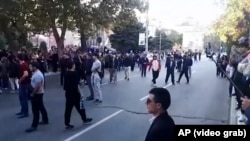After Russian President Vladimir Putin announced a military mobilization on September 21 to bolster flagging Russian forces invading neighboring Ukraine, protests erupted in towns and cities around the country.
However, the North Caucasus region of Daghestan grabbed the spotlight with some of the fastest, largest, and most insistent protests.
"We will fight until the last breath," said one female protester in the settlement of Babayurt who asked that her name be withheld out of fear for her safety.
On September 22, Babayurt district residents blocked a federal highway, while another group in the same area confronted military personnel at a local draft office. In the following days, the unrest spread to the settlement of Endirei in the nearby Khasayurt district before reaching the Daghestani capital of Makhachkala.
Babayurt and Khasayurt are both predominantly populated by Kumyks (also known as Qumuqlar), a Turkic-speaking, Muslim ethnic group that numbers some 500,000 people, a figure that has been increasing significantly in recent years. Daghestan, a predominantly Muslim region on the Caspian Sea east of Chechnya, is home to dozens of ethnic groups.
"There have been a lot of soldiers from these settlements already," said Denis Sokolov, a specialist in North Caucasus ethnic studies with the Free Russia Foundation.
"Many Kumyks have been to the war. And some have been killed, and there were a lot of men who refused to fight. Some of them only just returned from the war and now they are being mobilized again. They understand it will be very hard for them if they are sent back. Their mothers, wives, and sisters know perfectly well how that could end. So a conflict is inevitable."
The alarm surrounding the mobilization has exacerbated underlying tensions between the Kumyks and the ethnic Avars who also inhabit the area, Sokolov says.
"The Avars and Kumyks in the Babayurt and Khasavyurt districts are almost equal in number,” he explained to RFE/RL’s Idel.Realities. "But there are many Avars in the administrations and among the law enforcement and security agencies. Everything is superimposed on an old territorial conflict that has already become a political one."
"Mobilization is sending people off to war, everyone understands that," Sokolov added. "If the military commission comprises Avars, and the mobilized soldiers are Kumyks, that just raises the tensions."
The administrations of both districts ignored RFE/RL's requests for comment on the allegations that Kumyks were being disproportionately targeted by the mobilization.
Endirei is a settlement of some 8,000 people, one of the largest in the Khasavyurt district. Videos posted on social media on September 25 showed more than 100 people participating in an angry anti-mobilization demonstration, with police firing weapons into the air. According to local media, some 110 Endirei residents received mobilization orders, including some who had only recently returned from the Ukraine combat zone.
A few days later, Endirei residents reported on social media the authorities had ordered schoolteachers and other public-sector workers to participate in demonstrations in support of the mobilization. Muratbek Aidemirov, director of Endirei School No. 2, spoke to RFE/RL during a demonstration, saying he supported mobilization and planned to go to Ukraine himself "to fight for the motherland."
Aidemirov said without providing evidence that the anti-mobilization demonstration in Endirei had not been organized or attended by locals, but by unspecified people from outside the area.
The Telegram channel Zona Kavkaza commented on September 28 that the pro-mobilization demonstrations had been hastily organized to prove that Daghestan head Sergei Melikov "is in control of the situation in the republic and is carrying out the policies of the [ruling United Russia] party and Putin."
At the same time, local pro-government media resources depicted the anti-mobilization protesters as Islamist extremists and cowards, one Babayurt protester who asked that his name be withheld told RFE/RL.
"But all normal people know why we took to the streets," he added, saying that although he was subject to mobilization, he would not "go to fight and die for Putin."
"Ninety percent of those being called up are Kumyks," he asserted without giving evidence. "And what about the other nationalities? They don't touch them."
The pro-government Eurasia Daily website on September 27 cited a State Duma deputy from Daghestan, Biisultan Khamzayev, as saying the anti-mobilization protesters in Daghestan were directed by "Kyiv and Washington." The protesters, Khamzayev said, were "jihadists" and "anti-Russian Kumyk nationalists," a group he claimed had been waging a Turkish-directed jihad against Russia since the time of Tsar Peter the Great.
He did not elaborate or provide evidence to support the claims.
